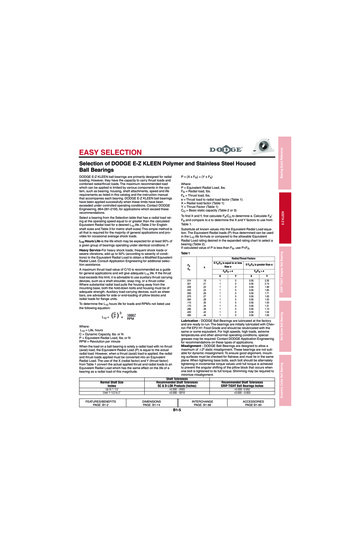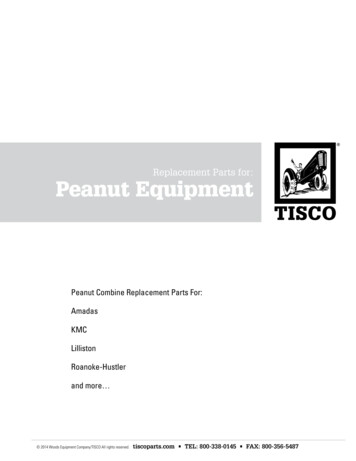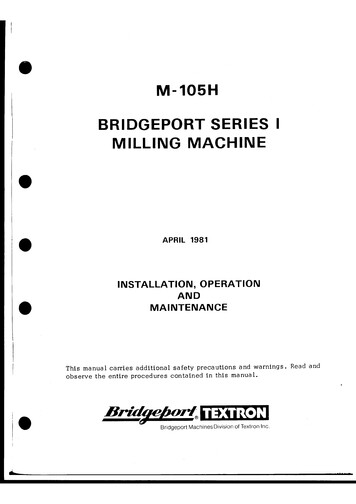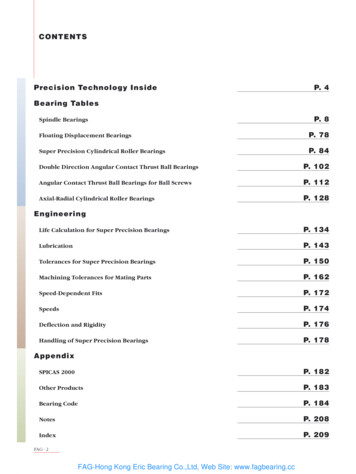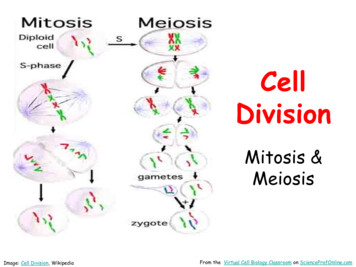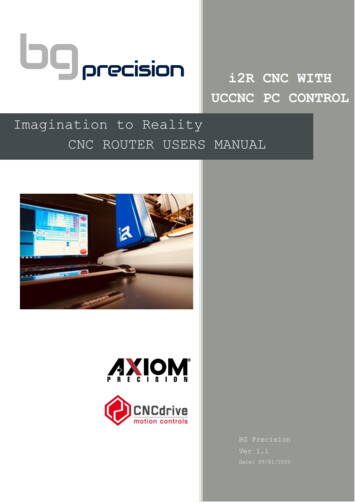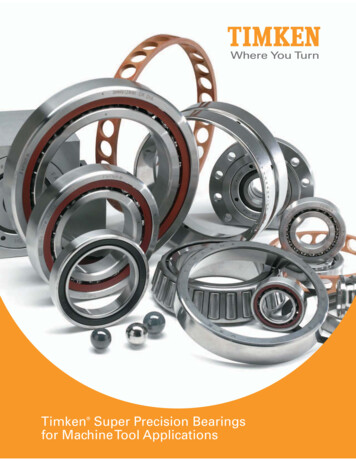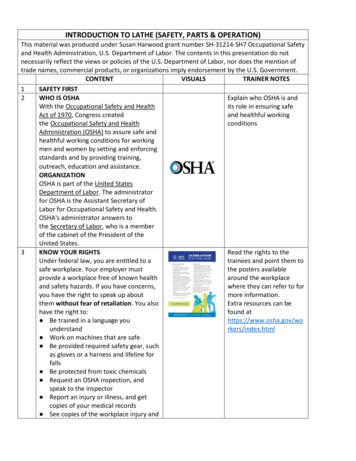
Transcription
MACHINE TOOL SPINDLE BEARINGSELECTION & MOUNTING GUIDESUBSCRIBE TO NSK NEWSLETTER
ContentIntroduction . 4Bearing SelectionNSK Super Precision Bearings – Product Range . 6Overview . 9Identification Markings .12Contact Angle .14Universal Sets .16Precision Grades.17Preload - Angular Contact Bearings .18Preload - Cylindrical Roller Bearings . 22Bearing Matching . 24Pre-MountingCleanliness and Washing. 26Greasing Process . 28Grease Quantities . 29Component Checks . 30MountingFitting Bearings to Shaft .32Locknut Torques / Spindle Runout Checks. 34Mounting Tapered Bore Roller Bearings. 38› Calculation Method . 38› Gauge Method . 42Classical Spindle Arrangements . 44Summary of Spindle Arrangements . 45› Heavy Duty Spindle. 46› Medium to High-Speed Spindle. 47UpgradingOverview . 54Robust Design. 56› Angular Control . 56› Cylindrical Roller Bearings . 57Bearing Material . 58Sealed Bearings. 59Sealed TAC .61Hybrid Bearings . 63TYN Cages . 64TAC Conversions . 65TB Cages. 66Supplementary InformationBearing Interchange Guide . 68Bearing Failure and Countermeasures . 70Trouble Shooting . 75Bearing Preload Conversion Tables . 78› Standard Angular Contact . 78› Robust Series . 82Bore and OD Matching Chart . 84Useful Tips . 87Index . 88Post-MountingPreload Checks . 48Alignment and Balance . 50Bearing ‘Run-in’ Procedures.51Trouble Shooting . 52› Cause of High Temperature. 52› Cause of Noise . 53MACHINE TOOL SPINDLE BEARING SELECTION & MOUNTING GUIDE 1
As one of the world’s leading manufacturers of rolling bearings, linear technologycomponents and steering systems, we can be found on almost every continent – withproduction facilities, sales offices and technology centres – because our customersappreciate short decision-making channels, prompt deliveries and local service.EuropeAsiaThe AmericasOceaniaAfricaThe NSK companyNSK commenced operations as the first Japanesemanufacturer of rolling bearings back in 1916. Eversince, we have been continuously expanding andimproving not only our product portfolio but also ourrange of services for various industrial sectors. In thiscontext, we develop technologies in the fields ofrolling bearings, linear systems, components for theautomotive industry and mechatronic systems. Ourresearch and production facilities in Europe, Americasand Asia are linked together in a global technology2network. Here we concentrate not only on thedevelopment of new technologies, but also on thecontinuous optimisation of quality – at every processstage.Among other things, our research activities includeproduct design, simulation applications using a varietyof analytical systems and the development of differentsteels and lubricants for rolling bearings.
Partnership based on trust –and trust based on qualityTotal Quality by NSK: The synergies of our global network of NSK Technology Centres.Just one example of how we meet our requirements for high quality.NSK is one of the leading companies with a long tradition inpatent applications for machine parts. In our worldwideresearch centres, we not only concentrate on the developmentof new technologies, but also on the continual improvementof quality based on the integrated technology platform oftribology, material technology, analysis and mechatronics.More about NSK at www.nskeurope.com or call us on 44 (0) 1 636 605 123MACHINE TOOL SPINDLE BEARING SELECTION & MOUNTING GUIDE 3
IntroductionThe successful build of a spindle will depend on close attention to details as illustrated below:Pre-test seaWHaeang4nmsRinnuGrRunning-InTrouble ShootingO-ckligFitting BearingsTo kiintngsMaCoBearing selectionrretchingctPrecision
Machine Tool Precision bearings are very accurately engineered components and as suchare very important to the successful performance of the machine tool. The way in whicha bearing is handled and fitted to a machine tool does not only determine if the machineoperates accurately but can also affect the life of the bearing in the spindle.This catalogue is intended to be a comprehensive guideto anyone who fits bearings to a machine tool regardlessto whether it is in planned maintenance or reactive to abreakdown. This catalogue follows a logical progressionthrough selection of the correct bearing types, to theimportance of cleanliness before attempting to assemble thespindle. A detailed part of assembly procedures is includedwith many photographs and drawings. Pre-test checks,‘running in’ and trouble shooting is also included to allow thebuilder more scope in solving spindle problems.A further section called Upgrading is included to explainhow to improve both the performance and most of allthe reliability of a spindle. In nearly all cases this can besimply done by replacing the bearing and no changes beingnecessary to the actual spindle design.Some sections include a useful tip like the one shown below,these tips are based on many years of experience and can beparticularly useful for newcomers to the spindle repair businessand a good reminder to the more experienced engineers.MACHINE TOOL SPINDLE BEARING SELECTION & MOUNTING GUIDE 5
Bearing SelectionNSK Super Precision Bearings –Product RangeSeveral types of Super Precision Bearings are available from NSK. These includethe ROBUST series of high performance bearings, special series of bearings forunique and specialised applications, and the standard series bearings.NSKHPS High Precision Angular Contact Ball BearingsBasic Super Precision Bearings manufactured to conform to ISO standards.› 70xx, 72xx, 79xx series› Contact angles: 15 (C), 25 (A5), 30 (A)› Cage design: phenolic (TR) or polyamide (TYN), depending on application requirements› Ball material: steel, ceramic (SN24)Standard SeriesSealed Angular Contact Ball BearingsPre-greased and sealed to reduce handling problems. Suitable for maintenance of machine tool spindles.› Standard series super precision angular contact ball bearings› ROBUST series high-speed angular contact ball bearings› Bore size range: ø30–100 mm in ISO series 10 and 19 (70xx and 79xx)Special SeriesDouble Row Cylindrical Roller BearingsDesigned to deliver high rigidity in high-speed applications such as lathe spindles.› Cage material: brass (MB), PPS resin (TB)› Standard specification E44: Outer ring oil holes and grooveStandard & High Rigidity SeriesHigh Precision Angular Contact Ball BearingsSuitable for high-speed and high precision motors.› Cage material: ball guided polyamide cage (T1X,TYA), inner ring guided phenolic cage (T), selection depends on theapplication› Suitable for silent or low vibration operationSpecial Series6
Ultra High Precision Angular Contact Ball BearingsHigh performance bearings developed specifically for internal grinding or high-speed motorapplications under spring preload.› Bore size range: ø6–25 mm, contact angle: 15 › Ball material: steel (S type), ceramic (H and X type)› Non separable type› Universal combinations (DU and SU)BSR SeriesHigh-Speed Angular Contact Thrust Ball BearingsHigh rigidity thrust bearings for lathe applications.› Contact angles: 30 (BAR), 40 (BTR)› Ball material: steel (S type), ceramic (H type)ROBUST Series: BAR & BTRUltra High-Speed Angular Contact Ball BearingsHigh performance bearings developed for high-speed operation with low temperature rise.Suitable for ultra high precision machining applications, and ultra high-speed applications.› Contact angles: 18 (BNR), 25 (BER)› Ball material: steel (S type), ceramic (H and X type)› Cage design: phenolic (T), polyamide (TYN), depending on application requirements› ROBUST series also can be used for ultra high speed applications of over 3 million dmn.ROBUST Series: BNR & BERUltra High-Speed Single Row Cylindrical Roller BearingsHigh performance cylindrical bearings designed for ultra high-speed applications,such as machining centre spindles.› Cage material: brass (MR)(1), PEEK resin (TP)› Roller material: steel, SHX, ceramic› Ultra high-speed ROBUST RXH design can be used up to 3 million dmn.(1)MR cage is used in the standard seriesROBUST Standard SeriesMACHINE TOOL SPINDLE BEARING SELECTION & MOUNTING GUIDE 7
Bearing SelectionNSK Super Precision Bearings –Product RangeHigh Precision Angular Contact Ball Bearings - RobustShot SeriesDirect oil-air lubrication in order to achieve highest speeds.› Direct air-oil Lubrication via a through-hole in the outer ring› Contact angles: 18 (BNR), 25 (BER)› Lubrication groove with O-rings in the outer ring› Hybrid bearings - steel rings, ceramic ballsROBUSTSHOT SeriesNSKHPS Angular Contact Thrust Ball Bearings for Ball Screw SupportHigh rigidity thrust bearings designed specifically for ball screw support applications in machine tools.› Contact angle: 60 › Can be universally matched to any required rigidity specification or life cycle› A pre-greased line using special grease is also available› Can be supplied with contact seals and waterproof greaseSpecial Seriesfor Machine Tool ApplicationsAngular Contact Thrust Ball Bearings for heavy duty Ball Screw SupportThe high load capacity design delivers five times the life expectancy compared to ball screw support bearings formachine tool applications of a similar size. The number of rows can also be reduced.› Easier handling than tapered roller bearings or thrust spherical roller bearings as a resultof non-separable configuration› Optimum ball bearing design results in lower rotational torqueSpecial Seriesfor Injection Molding Machines› Can be universally matched to any required rigidity specification or life cycleNSKHPS BSBD Ball Screw Support BearingsThe double row configuration, enables the bearings to support large axial forces in both directions.› BSN series withouth flange, BSF series with flange› Paired types also available› Contact lip seal - provides good sealing at high speedsBSN & BSF Series8
Bearing SelectionOverviewAngular Contact Ball BearingConventional Type 72, 70, 79 Series7016A5TRV1VBearing SeriesBore NumberContact AngleA 30 A5 25 C 15 MaterialBlank Symbol: Bearing Steel (SUJ2)SN24: Ceramic BallsRetainerTR: Phenolic CageTYN: Polyamide CageSealNo symbol: Open typeV1V: Non contact rubber sealMounting ConfigurationSU: Single UniversalDU: Duplex UniversalDB, DF, DT: Duplex ArrangementDBD, DFD, DTD, DUD: Triplex ArrangementDBB, DFF, DBT, DFT, DTT, QU: Quad ArrangementPreloadL: LightM: MediumH: HeavyGxx: Preload in Kgf (G5 5 Kgf)CPxx: Median Preload in Microns (CP10 10µm)CAxx: Median Axial Clearance in Microns (CA15 15 µm)Precision ClassP4: ISO Class 4 (ABEC7)P3: Dimensions - ISO Class 4Running Accuracy - ISO Class 2P2: ISO Class 2 (ABEC9)DUROBUST Series, High-Speed TypeLP380BER10STV1VSUELP3Nominal BoreDiameterBearing TypeBNR: 18 Contact AngleBER: 25 Contact AngleBSR: 15 Contact AngleDimension Series10: Same bore diameter, outsidediameter & width as the 70 series19: Same bore diameter, outsidediameter & width as the 79 seriesMaterialS: Steel BallH: Ceramic BallX: SHX rings, ceramic ballsRetainerT: Phenolic CageTYN: Polyamide CageT42: PEEK CageSealNo Symbol: Open typeV1V: Non contact rubber sealMounting ConfigurationSU: Single UniversalDU: Duplex UniversalDB, DF, DT: Duplex ArrangementDBD, DFD, DTD, DUD: Triplex ArrangementDBB, DFF, DBT, DFT, DTT, QU: Quad ArrangementPreloadEL: Extra LightL: LightGxx: Preload in Kgf (G5 5 Kgf)CPxx: Median Preload in Microns (CP10 10µm)CAxx: Median Axial Clearance in Microns (CA15 15µm)Precision ClassP4: ISO Class 4 (ABEC7)P3: Dimensions - ISO Class 4 Running Accuracy - ISO Class 2P2: ISO Class 2 (ABEC9)MACHINE TOOL SPINDLE BEARING SELECTION & MOUNTING GUIDE 9
Bearing SelectionOverviewBall Screw Support BearingsBSF3080DDUHCylindrical Roller BearingsP2BDTNN3017MBKRE44CC0P4CylindricalRoller DesignatorNN: Double Row, Inner Ring Guided RollersN: Single Row, Inner Ring Guided RollersSeries(Ball Screw Support)F: Flange typeN: No Flange typeWidth SeriesBoreDiameter SeriesOuter diameterBore codeSeal typeMaterialSingle RS: Bearing Steel (SUJ2) (rings and rolling elements)RX: Heat Resistant Steel (SHX) (rings and rolling elements)rowonlyRXH: Heat Resistant Steel (SHX) for rings and ceramic rolling elementsNo symbol: SUJ2 steelPreloadClass Iso 2No symbol: single bearingDT: paired bearingRetainerMB: Roller guided machined brass cage (Double Row)TB: Roller guided PPS resin cage (Double Row)TP: Outer ring guided PEEK resin cageMR: Roller guided machined brass cage (Single Row)Ball Screw Support Bearings30TAC62CDDGSUHPN7CBearing Bore*(mm)Bearing TypeBearing O.D.* (mm)Internal DesignB: High Capacity and Higher Speed(Replaces “A” type)Bore ConfigurationKR: Ultra Precision Tapered Bore (1:12)Blank symbol: Cylindrical boreLubricationE44: Outer ring with machined lubrication groove and holes(Double Row Only)Radial Clearance** CC1: Standard clearance for cylindrical bore** CC0: Standard clearance for tapered boreCCG: Special radial clearancePrecision ClassP2: ISO Class 2 P4: ISO Class 4Seal SymbolNo symbol: Open typeDDG – Low friction contacting sealV1V - Non contact rubber sealMounting ConfigurationSU: Single UniversalDU: Duplex UniversalDB, DF, DT: Duplex ArrangementDBD, DFD, DTD, DUD – Triplex ArrangementDBB, DFF, DBT, DFT, DTT, QU - Quad ArrangementPreloadPrecision Class*For inch series bearings, the fractional portion of the size is omitted.**CC0 clearance (NSK’s recommended clearance): CC0 clearance range less than CC1. This range overlaps with the upper values of CC9 and lower values of CC1.As this clearance is easy for customers to target this range, it is the preferred clearance offered for CRB with taper bore.CC1 clearance: Matched clearance range greater than CC0. While not the standard, this clearance is most popular in the field.10
RobustShot Series80BNR10HTE34DDBEL P3Y3Example:O-ringsNominal bore diameterDegree of accuracyBearing designPreloadSeries optionBearing arrangementMaterialROBUSTSHOT designCageThrust Angular Contact Ball Bearing100BAR10STYNDBLP4A100Bearing BoreDiameter (mm)Bearing BoreDiameter (mm)Bearing TypeBAR: 30 Contact AngleBTR: 40 Contact AngleBearing TypeDimension Series10X: Arranged with NN30XX SeriesMaterialS: Steel Ball H: Ceramic BallRetainerTYN: Polyamide CageCombinationDB: Back to Back DuplexPreloadL: Standard PreloadEL: Standard Preload for High-Speed ApplicationsCP: Special PreloadCA: Special Axial ClearanceTAC20DPN7 LC6Dimension Series20D: High-Speed Typew/Revised Internal FeaturesPrecision ClassPN7: ISO Class 4, O.D. is specialSpacer (Inner Ring)Preload ClassC6: Standard Preload for Grease LubricationC7: Standard Preload for Oil LubricationTAC size range from 140mm to 280mm.Precision ClassP4A: ISO Class 4, O.D. is SpecialP2A: ISO Class 2, O.D. is SpecialMACHINE TOOL SPINDLE BEARING SELECTION & MOUNTING GUIDE 11
Bearing SelectionIdentification MarkingsNSK Precision bearings carry useful information for both the designers and fitters.The box itself will indicate date codes, serial numbers, bore, outer diameter andwidth deviations. This information is also found on the bearing so even if the box islost/missing, all the relevant information is still available.Product Serial NumberEvery NSK brand bearing has a unique serial number; thisenables complete traceability of the product since finalinspection data is stored within NSK records associated withthis number.on page 13 indicates that in this example the bearing innerring bore is 25mm –1 microns i.e. the exact size is 24.999mm.*The outer ring is 47mm –3 microns i.e. the exact size is46.997mm.*. The bearing width is 12mm – 57 microns i.e. theexact size is 11.943mm.** Bearing envelope dimensions found from the global catalogueSize DeviationsEvery precision bearing is 100% inspected and the sizedeviations are indicated on both the box and the bearing.The outer ring contains the size deviation of the outer ring ODand the bearing width deviation respectively and the innerring contains the size deviation of the inner ring bore.This information is also placed on the box. The example box1 OD Size Deviation6 Inner Ring ‘High Point’ Marking2 Width Size Deviation7 Bearing Designation3 Product Serial Number8 Bore Size Deviation4 Brand9 Country of Manufacturef and bThe ‘f’ refers to the front face preload step and the ‘b’ refersto the rear face preload step. The value of ‘f’ and ‘b’ are theabsolute step in microns and is recorded on the box labelrounded to the nearest micron.Open Facef5 Vee Marking4bMarked Side of Outer Ring3625187912Vee Lining – Individual BearingsA single Vee line is placed on the outer diameter of the outerring. The positioning of the Vee serves two purposes:1. The radial position indicates the point of maximum ringthickness, i.e. the position of maximum outer ring runout.2. The point of the Vee indicates the open face of thebearing. This is particularly useful when using sealed bearingssince the same size seal is often used on each side of thebearings making it difficult to see which is the open face.
Examples of matched setswith overall vee line:AppliedAxial LoadAppliedAxial LoadFront ofSpindleFront ofSpindleHigh Point MarkingD:-3 Outer Ring ODd:-1 Inner Ring BoreC:-57 Bearing Widthf:-1 Front Face Preloadb:-1 Rear Face PreloadVee Lining – Bearing SetsIf bearings are ordered in matched sets there will also bea vee line marked across the complete set as well as theindividual vee line. Bearings used in matched sets shouldnot be taken out of the sequence of the set.The direction of the overall vee also indicates the directionof axial loading; this is important when the bearingarrangement is non-symmetrical as shown above.High Pointof ShaftHigh Point Markon Inner RingInner Ring High Point MarkingThe ‘O’ on the face of the inner ring indicates the positionof the maximum ring thickness i.e. the position of maximumring runout. (See 6 on page 12)High Point in HousingHow to use High Point MarkingOptimum running accuracy is achieved when the bearing ismounted so that the ring high points are directly opposite(180 ) to the high points on the housing and shaft. Withregard to the shaft, find the high point using a suitable DTI(Dial test indicator) and mount the bearing with the inner ringhigh point at 180 . With regard to fitting the outer ring intothe housing, mount the outer ring vee mark 180 to the highpoint measured in the housing.If the runout of the shaft is measured at 2µm, placing theinner ring as shown above can help to reduce the runoutclose to zero. The shaft runout is much more importantthan the housing runout, which can also be more difficultto measure accurately.High Point on Ring1. Useful TipIf it is not possible to measure the shaft andhousing runouts it is advisable to position the bearinghigh points out of line so as to avoid accidentallyaligning the bearing high points with the shaft highpoints thereby increasingoverall runout.MACHINE TOOL SPINDLE BEARING SELECTION & MOUNTING GUIDE 13
Bearing SelectionContact AngleA fundamental part of the angular contact bearings is the contact angle. These bearingscan only take axial load in one direction unless they are used in sets (see universal sets).Loading against the contact angleLoad through the inner ring in theor on the face of the outer ring willdirection of the contact angle.cause the rings to be disassembled.x, y Points of Contact15 oContact Angles25 oxyyContact Angle15 oC7006 TRSULP325 oA5TRSULP3700630 o7006ATRSULP3More popular in Japan14x-0 AXIAL LOADRADIAL LOADSPEEDAXIAL LOADRADIAL LOADSPEEDAXIAL LOADRADIAL LOADSPEEDPopular Contact Angles:Standard Precision15 25 High-Speed ‘Robust’ 18 25 Thrust30 40 Ball Screw Support60 As the contact angle increases, the axial load capacityincreases but the speed and life decrease. Angular contactbearings with small contact angles are more suitable forhigh-speeds and radial loads.Effect of Contact Angle – Standard DesignationsFor high-speed products; 18 has been adopted as thelowest standard contact angle. This has been shown tobe more effective at high-speeds in terms of bendingstiffness compared to 15 . An 18 contact angle providesbetter axial stiffness than 15 , but less radial stiffness.However, as seen from the spindle diagram, bendingstiffness is more important.
15 15 15 18 18 18 Axial StiffnessBendingStiffnessAxialStiffnessBuilt-in MotorRadialStiffnessBending StiffnessRadial StiffnessFor high-speed applications using motorised spindles, theinternal heat generation can be much higher than belt drivenspindles; this can reduce the bearing internal clearance andsometimes cause failure at high-speed.For these applications it is more beneficial to select a 25 contact angle because this has a greater radial internalclearance (RIC) compared to the 18 contact angle and canmore easily accommodate a reduction in internal clearancedue to thermal movement.Examples of Contact Angle –High-Speed and Thrust Designations25BGR10STDUELP2 15 Robust High-SpeedGrinding Applications30BNR10STDBELP 18 Robust High-Speed30BER10STDBELP3 25 Robust High-Speed30BAR10STYNDBELP3 30 Robust Thrust30BTR10STYNDBELP3 40 Robust Thrust30TAC62BDFC9PN7A 60 Ball Screw SupportMACHINE TOOL SPINDLE BEARING SELECTION & MOUNTING GUIDE 15
Bearing SelectionUniversal SetsThe term universal means that the bearings can be used in any arrangement, tandem,back to back or face to face.The preload step is manufactured on the rear face of theinner ring and the front face of the outer ring, both steps areexactly the same depth therefore the universal bearing canbe used in any combination.αfBack to Backf: Offset of Front Faceb: Offset of Rear FaceFace to FacebSUDUDUDQUUniversal Bearingf b TandemSingle Universal BearingDuplex Universal BearingTriplex Universal BearingQuadruplex Universal BearingBack to Back (DB Arrangement)The majority of machine tool applications use this type ofarrangement. The preload is produced by the ‘Gap’ (2 x thestep b) of the inner ring faces being squeezed together by alocknut on the shaft. This type of arrangement is particularlyuseful where moment loads are used but the accuracy of thehousing must be high to reduce misalignment.Other universal bearing combinations are shown below:DUCombinationsDBDFDTDUDFace to Face (DF Arrangement)This arrangement is often used for ball screw support bearingapplications. The preload is produced by the ‘Gap’ (2 x thestep f) of the outer ring faces being squeezed together by anend cap in the housing. This type of arrangement is particularlyuseful when good alignment cannot be guaranteed betweenthe housings. This can be the case for Ball Screw SupportBearings since ball screws can often be 1 to 5 metres in length.CombinationsDBDDFDDBBTandem (DT Arrangement)This arrangement needs to be used with another bearing orset of bearings in the opposing direction in order to producea preload (see diagram). Bearings are used in thesearrangements when there is a need for higher stiffness dueto higher axial loads on the spindle.DTDDFFDBTQUCombinationsDFT16DTT
Bearing SelectionPrecision GradesBearings are manufactured in different precision grades. The lower P number the smallerthe tolerance and greater the running accuracy.NSKP5P4P3*P2British Standards Institution (BS 292)EP5EP7-EP9Anti-Friction Bearing Manufacturers Association(AFBMA, Standard 20)ABEC5ABEC7-ABEC9International Standards Organisation (ISO 492)Class 5Class 4-Class 2P5P4-P2DIN (Deutsche Industrie Norm)The table above shows the comparison of different accuracystandards. NSK use the DIN system where P2 is the greateraccuracy. Additionally NSK have introduced a P3 (same externalaccuracies as P4 but higher internal accuracies, same as P2).Effects of Internal Tolerances –Radial and Axial RunoutsP2 and P3 tolerance is the highest internal geometry accuracy;this results in the best radial and axial runout values.* P2 Runout, P4 External TolerancesNominal DiaTotal OD ToleranceExternal TolerancesP2Single Micron GradingAll NSK bearings have single micron grading for bore, OD &width. This means that the exact dimensions of every bearingcan be found.P4 & P3P2P4 & P30Nominal BoreTotal Bore ToleranceBearing sets are matched to within 1/3rd of the overalltolerances. This is to enable optimum load sharing when fittedto the shaft and housing. P2 external tolerances tend to beapproximately half of P4 and therefore are sometimes usedfor random matching. However there is a price penalty for P2standard.Radial RunoutP2 & P3P4Axial Runout0P2 & P3P4Typical Tolerances for 7014 (µm)P4Example:The bearing on the right (7008CTYNSULP4)has nominal dimensions from catalogue of:Width SizeDeviationOD 68mmDeviation on bearing and box –4µmTherefore exact OD 67.996mmBore 40mmDeviation on bearing and box –4µTherefore exact bore 39.996Width 15mmDeviation on bearing and box –100µmTherefore exact width 14.900mmBore SizeDeviationOD SizeDeviationP3P2Bore0 to -70 to -70 to -4OD0 to -80 to -80 to -5Width0 to -1500 to -1500 to -150Radial Runout0 to 40 to 2.50 to 2.5Axial Runout0 to 50 to 2.50 to 2.52. Useful TipThe use of P3 Precision grades is more cost effectivethan P2. With single micron grading it is possible toselect the correct bearings for matching into sets.Internal geometry of P3 is the same as P2.MACHINE TOOL SPINDLE BEARING SELECTION & MOUNTING GUIDE 17
Bearing SelectionPreload – Angular Contact BearingsThe preload between angular contact bearings is achieved by clampinga pair or multiple number of bearings together.NSK has 4 standard preload arrangements as shown on leftside. This allows greater flexibility in machine design and moreimportantly when replacing different brands.MEDIUM (M)EXTRA LIGHT (EL)LIGHT (L)All angular contact bearings need to operate with preloaddue to the following reasons:› Elimination of radial and axial play› Increased rigidity› Reduced runouts, increasing accuracy› Helps to prevent ball skid at high-speedHEAVY (H)There are two types of preloading methods:1) Constant Pressure (Spring Preload)This type of preload is primarily use for grinding applicationsor very fast machining. The speeds quoted in the catalogueare all for this type of preload. This preload is achievedby the use of sets of coiled or weaver disc springs. In thearrangement (Fig.X), even if the relative position of thebearings change during operation the magnitude of thepreload remains relatively constant.Constant Pressure Preload (Spring Preload)Spring Carrier2) Position Preload (Fixed Preload)This is the most common type of preload arrangement andcan either be arranged with or without spacers. The mainadvantage of this type is that the stiffness (rigidity) is muchhigher. However, the speed quoted in the catalogue needsto be factored according to the amount of preload andnumber of bearings in the set.This information is given in the NSK Super Precisioncatalogue and printed below for reference.Position Preload DBB0.800.750.600.45DBD0.750.700.550.40Speed Factor TableNSK has the most levels of standard preload available:EL Extra light – fastest speed, less rigidityL Light – slightly higher rigidityM Medium – lower speed, good rigidityH Heavy – highest rigidity, lowest speed
Special Preloads and Axial ClearanceGxx is special preload (xx is the mean preload in kgf)CPxx is special preload (xx is the mean preload gap in µm)CAxx is a special clearance (xx is measured axial
MACHINE TOOL SPINDLE BEARING SELECTION & MOUNTING GUIDE 9 Bearing Selection Overview Conventional Type 72, 70, 79 Series Bearing Series Bore Number Contact Angle A 30 A5 25 C 15 Material Blank Symbol: Bearing Steel (SUJ2) SN24: Ceramic Balls Retainer TR: Phenolic Cage TYN: Poly
